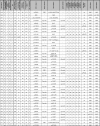Niemann-Pick disease type C clinical database: cognitive and coordination deficits are early disease indicators
- PMID: 23433426
- PMCID: PMC3649939
- DOI: 10.1186/1750-1172-8-35
Niemann-Pick disease type C clinical database: cognitive and coordination deficits are early disease indicators
Abstract
Background: The neurodegenerative lysosomal storage disorder Niemann-Pick disease type C (NP-C) is characterized by a broad clinical variability involving neurological, psychiatric and systemic signs. Diverse patterns of disease manifestation and progression considerably delay its diagnosis. Here we introduce the NP-C clinical database (NPC-cdb) to systematically obtain, store and analyze diagnostic and clinical findings in patients with NP-C. We apply NPC-cdb to study NP-C temporal expression in a large German-Swiss patient cohort.
Methods: Current and past medical history was systematically acquired from 42 patients using tailored questionnaires. Manifestation of 72 distinct neuropsychiatric signs was modeled over the course of disease. The sequence of disease progression was re-constructed by a novel clinical outcome scale (NPC-cdb score).
Results: The efficiency of current clinical diagnostic standards negatively correlates with duration of disease (p<3.9x10(-4)), suggesting insufficient sensitivity in patients early in the disease process. Neurological signs considered as typical for NP-C were frequent (e.g., cognitive impairment 86%, ataxia 79%, vertical supranuclear gaze palsy 76%) and their presence co-occurred with accelerated diagnosis. However, less specific neuropsychiatric signs were reported to arise considerably more early in the disease process (e.g., clumsiness -4.9±1.1 y before diagnosis). Most patients showed a steady disease progression that correlated with age at neurological onset. However, a distinct subcohort (n=6) with initially steadily progressing disease later showed a 2.9-fold accelerated progression that was associated with the onset of seizures (p<7x10(-4)), suggesting seizures as predictive for a poor prognosis.
Conclusions: Considering early, but less specific neuropsychiatric signs may accelerate the path to diagnosing NP-C in a patient.
Figures






References
-
- Patterson MC. In: The metabolic and molecular bases of inherited disease. CR S, editor. New York: McGraw Hill; 2001. Niemann-pick disease type C: a lipid trafficking disorder; pp. 3611–3634.
Publication types
MeSH terms
LinkOut - more resources
Full Text Sources
Other Literature Sources
Medical
Miscellaneous

